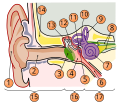File:Anatomy of Human Ear with Cochlear Frequency Mapping.svg

Size of this PNG preview of this SVG file: 674 × 519 pixels. Other resolutions: 312 × 240 pixels | 624 × 480 pixels | 998 × 768 pixels | 1,280 × 986 pixels | 2,560 × 1,971 pixels.
Original file (SVG file, nominally 674 × 519 pixels, file size: 33 KB)
File history
Click on a date/time to view the file as it appeared at that time.
| Date/Time | Thumbnail | Dimensions | User | Comment | |
|---|---|---|---|---|---|
| current | 21:29, 16 September 2018 |  | 674 × 519 (33 KB) | JoKalliauer | added systemLanguage="eo" |
| 17:21, 16 September 2018 |  | 674 × 519 (32 KB) | JoKalliauer | added systemLanguage="de" | |
| 05:33, 11 September 2018 |  | 674 × 519 (87 KB) | Jmarchn | Bigger (proportional real size) and full redraw (more realistic) of the auricle. Ossicles in white colour. Eardrum with contour. Added 3 labels. Add fundus to the bone and subcutaneous tissues, add superior auricular muscle, add transparency to middle ear, add separation between middle and inner ear, add division to internal auditory canal. | |
| 13:40, 29 April 2009 |  | 800 × 600 (98 KB) | Inductiveload | swap incus/malleus | |
| 15:10, 15 February 2009 |  | 800 × 600 (98 KB) | Inductiveload | {{Information |Description={{en|1=The human ear and frequency mapping in the cochlea. The three ossicles incus, malleus, and stapes transmit airborne vibration from the tympanic membrane to the oval window at the base of the cochlea. Because of the mechan |
File usage
The following 2 pages use this file:
Global file usage
The following other wikis use this file:
- Usage on en.wikipedia.org
- Usage on eo.wikipedia.org
- Usage on he.wikipedia.org
- Usage on lt.wikipedia.org
- Usage on www.wikidata.org

















































